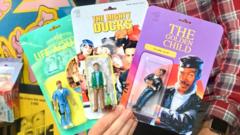The rapid expansion of artificial intelligence (AI) in the creative domain, particularly the trend of generating "starter pack" images depicting people as dolls, has sparked significant backlash among artists. This artistic community claims that such innovations not only threaten their livelihoods but also compromise the integrity and originality of their work.
Since April, there has been a flood of individuals submitting their photographs to be transformed into AI-generated dolls. While such technology may seem novel, many artists have raised alarms over the underlying implications, including privacy concerns, potential environmental damage, and the risk of diluting genuine creativity.
Nick Lavellee, a custom action figure maker operating under the brand Wicked Joyful, has voiced his worries, stating that the oversaturation of AI-generated images on social media is diminishing the unique artistry of his handcrafted figures. Lavellee, who has gained success creating figures for public figures and celebrities—some of which sell for up to $250—now fears a decline in commission work as AI replica images gain popularity.
The sentiment against AI-generated products has been bolstered by the emergence of the #StarterPackNoAI movement, which has gained traction on social media platforms. Artists have rallied around this initiative, including Barcelona-based artist Maria Picassó Piquer, who noted the stark contrast in variety and "humanity" between AI imagery and handcrafted art.
Illustrator Dav le Dessineux, working from Bordeaux, reflected that the impact of AI on the design industry is already being felt, with some artists losing contracts to automated processes. He too participated in the starter pack trend, emphasizing the need to return to traditional artistic tools instead of relying on digital technology.
Further voices in the art community, like Eli Dibitonto from Italy, have echoed similar sentiments, celebrating the joy and imperfection inherent in creating art the old-fashioned way, rather than through AI's quick, seamless processes. Evie Joyce, another illustrator, emphasized that art is a reflection of personal experiences and effort, something AI lacks in its production.
While Lavellee acknowledges the potential benefits of AI as a tool, he hopes the public will recognize the value of his work over digital imitations. He expresses optimism that, despite the rise of AI dolls, there will always be appreciation for the artistry of handmade items.
As discussions around the implications of AI-generated art continue to gain momentum, creatives across the board are striving to assert their human touch in a world increasingly dominated by computational images. The ongoing debate raises crucial questions about the future of artistry in the face of advancing technology—will genuine creativity survive, or will it be overshadowed by algorithm-driven designs?






















